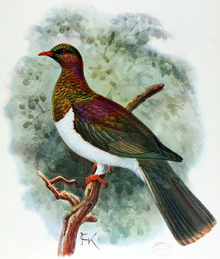| Norfolk pigeon | |
|---|---|

| |
| Illustration by Keulemans, 1907 | |
| Conservation status | |
 Extinct (early 20th century) (IUCN 3.1) | |
| Scientific classification | |
| Domain: | Eukaryota |
| Kingdom: | Animalia |
| Phylum: | Chordata |
| Class: | Aves |
| Order: | Columbiformes |
| Family: | Columbidae |
| Genus: | Hemiphaga |
| Species: | H. novaeseelandiae |
| Subspecies: | †H. n. spadicea |
| Trinomial name | |
| †Hemiphaga novaeseelandiae spadicea Latham, 1801 | |
The Norfolk pigeon or Norfolk Island pigeon (Hemiphaga novaeseelandiae spadicea), sometimes called the wood quest, is an extinct subspecies of the New Zealand pigeon (kererū) that inhabited Norfolk Island. This population probably colonised Norfolk Island from New Zealand during the Pleistocene. It became extinct around the turn of the 20th century.
Taxonomy
German naturalist Johann Reinhold Forster described the Norfolk pigeon as Columba argetraea in 1794, however the name was not used. English ornithologist John Latham described it as Columba spadicea in his 1801 work Supplementum Indicis Ornithologici.
Twenty specimens of the Norfolk Pigeon are known. Three of these are in the Natural History Museum, Leiden, two in the Natural History Museum New York and one specimen in World Museum Liverpool. DNA collected and analyzed from toepad tissue indicated that the Norfolk Island pigeon is genetically sister to the New Zealand Hemiphaga novaeseelandiae population.
Early records from Norfolk Island indicate the local people gave it the name "wood quest", however the name was not passed on from the second settlement to the Pitcairn settlers. The term is related to the words "queece", "queest" and "quist" used for the wood pigeon in the West Midlands and southwestern England.
Ecology


The abundance of the Norfolk pigeon at the time of the island's settlement is unknown. Early records indicate the presence of the bird, but do not contain any information on its numbers. Based on the behaviour of the other subspecies, it is likely that the bird relied upon fruiting plants for food.
Extinction
The extinction of the Norfolk pigeon was caused by a combination of the introduction of cats and weasels, habitat destruction by human settlers, and direct hunting by humans. Before European settlement, the bird had been hunted by Polynesian settlers of the island. When Europeans reached the island, however, the birds remained and the Polynesians did not. The Europeans took up the bird as a food source. An officer of the penal colony there, Ensign Abel Dottin William Best, recorded the species as still quite common in 1838, with his journals mentioning his successful hunting of 72 birds, including 25 on September 18, 1838. The last sighting occurred in 1901. Direct hunting by humans was probably the dominant cause of extinction.
Memorials
The Government of Norfolk Island released a stamp commemorating the bird on February 24, 1971.
References
- BirdLife International (2022). "Hemiphaga novaeseelandiae". IUCN Red List of Threatened Species. 2022: e.T22727557A209064496. Retrieved 23 July 2022.
- ^ Goldberg, Julia; Trewick, Steven A.; Powlesland, Ralph G. (2011). "Population structure and biogeography of Hemiphaga pigeons (Aves: Columbidae) on islands in the New Zealand region: Population structure of pigeons in New Zealand". Journal of Biogeography. 38 (2): 285–298. doi:10.1111/j.1365-2699.2010.02414.x. S2CID 55640412.
- Australian Biological Resources Study (20 August 2013). "Subspecies Hemiphaga novaeseelandiae spadicea (Latham, 1801)". Australian Faunal Directory. Canberra, Australian Capital Territory: Department of the Environment, Water, Heritage and the Arts, Australian Government. Retrieved 14 September 2021.
- R. Schodde, Australia Bureau of Flora and Fauna, I. J. Mason, Australian Biological Resources Study, W. W. K. Houston, A. Well (1997). Zoological Catalogue of Australia. CSIRO Publishing. p. 53. ISBN 0-643-06037-5.
{{cite book}}: CS1 maint: multiple names: authors list (link) - "Naturalis - Extinct bird: Hemiphaga novaeseelandiae spadicea (Norfolk Island Pigeon)". Nationaal Natuurhistorisch Museum. Archived from the original on 2011-06-08. Retrieved 2008-12-08.
- McAllan, Ian (1999). "A Common Name for the Norfolk Island Pigeon". Australian Bird Watcher. 18 (4): 179–180.
- ^ Stephen T. Garnett & Gabriel M. Crowley (2000). "New Zealand Pigeon (Norfolk Island)" (PDF). The Action Plan for Australian Birds 2000. Environment Australia. Archived from the original (PDF) on 21 May 2011. Retrieved 8 December 2008.
- Richard N. Holdaway & Atholl Anderson (2001). "Avifauna from the Emily Bay Settlement Site, Norfolk Island:A Preliminary Account" (PDF). Records of the Australian Museum. 27: 85–100. doi:10.3853/j.0812-7387.27.2001.1343. Retrieved 2008-12-10.
- James L. Moore (December 1985). "Ensign Best's bird observations on Norfolk Island" (PDF). Notornis. 32. Ornithological Society of New Zealand: 319–322. Archived from the original (PDF) on 2008-10-17. Retrieved 2008-12-10.
- Day, David (1989). The Encyclopedia of Vanished Species. Hong Kong: Mclaren Publishing Limited. ISBN 0-947889-30-2.
- "Bird Stamps Related To Captain James Cook" (PDF). Captain Cook Society. 2005. Retrieved 2008-12-10.
External links
| Taxon identifiers | |
|---|---|
| Hemiphaga novaeseelandiae spadicea | |